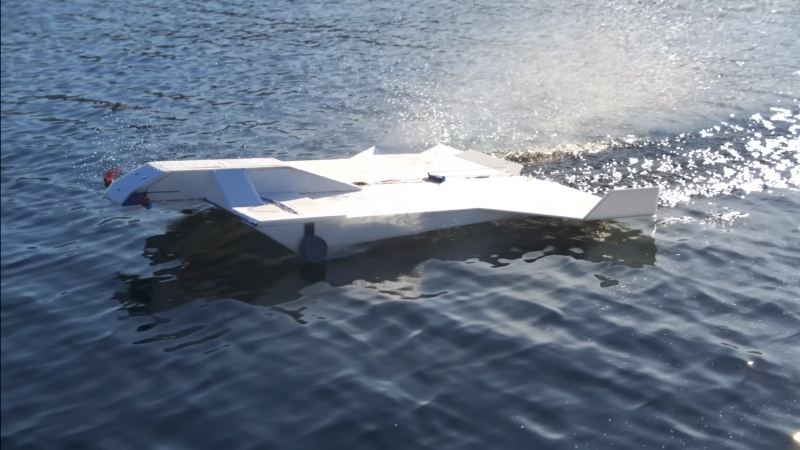Who said paddle wheels were just for leisurely riverboat cruises? [rctestflight] is smashing that image with a high-speed twist on the concept, using paddle wheels to propel a ground effect vehicle across water. In the video after the break, witness this blend of old and new as he tests various designs.
Over the past few years he’s worked on a series of ground effect vehicles which exploits the increased lift and reduced drag when flying close to a surface. Unlike full-sized counterparts, smaller RC models struggle to stay in this sweet spot due to less pronounced self-stabilizing feedback loops. This means a small scale vehicle tends to touch the water rather often, and bleeding a lot of momentum in the process.
He wanted to convert these losses into gains by giving the vehicles a boost of speed whenever it touches the water. It’s a popular trick with RC cars which will hydroplane for long distances as long as they can maintain speed. All the designs still required air propellers for takeoff and to help maintain speed. The final design didn’t really need the paddle wheel when the air and water was calm, but it definitely helped when things got choppy. He is already experimenting with different paddle designs but also plans to test some other types of surface drives.
For covered a number off small scale ekranoplans, including a previous version by [rctestflight] that uses lidar for altitude control. He has also collaborated with [Think Flight] to build a autonomous small scale prototype for a maritime shipping startup.

















Seems like the secret to his success is to use AG1. Think I might get some to boost the development of my own projects.
Simply replace ag1 through something healty, water for example and enough sleep, little bit teamsport and learn to cook non processed foods. Visit your family regularly, your frinds. Find a country to work with non toxic worklife. And keel going.
If you have the option being depressed in your city or somewhere with more sunshine on this globe, choose sun.
Too late …. just ordered 2kg of AG1 and an intravenous drip off Amazon.
“And keel going”
Egads! I hope that isn’t something like keel hauling!
B^)
I read your comment before starting the video. I had no idea what is AG1.
The long commercial for AG1 so near the start of the video ended it for me.
Yep, it spoiled it for me too. Still gonna try the AG1 though.
Do a merge between this and https://hackaday.com/2022/09/29/a-drone-for-the-rest-of-us/ , so probably normal ground effect vehicle plus some small downward facing fans to blow a little more air underneath whenever it’s needed? Because vehicle is small, it would need to react very fast to changes, so probably constantly blowing a fan with automatic flap directing some air underneath, controlled by computer.
He can sell it to sado maso guys as the slap-tronic-4000.
I was talking with a farmer who was exploring if it would be possible to put a spray rig on a hovercraft frame for spraying and spreading fertilizer with minimal groundpressure/compaction issues early in the season when the ground was wet. He figured he could do it but there was the problem of “side-slip” in any sort of slope, and the difficulty of keeping straight rows to get even application.
I suggested side-wheels to act as a sort of keel, but he figured they already made balloon tired spreaders so that would not be much of an improvement to justify the cost and time.
I thought it was a wonderful project, I could imagine LARPing Hammer’s Slammers’ Hovertanks across grass seed fields in the winter.
“for spraying and spreading fertilizer with minimal groundpressure/compaction issues early in the season when the ground was wet.”
It’s called a crop dusting helicopter.
Helicopters run very high per hour, and this was prior to drones. the goal was to get something that would be cheap to build run and service, and would have low ground pressure. Locally the farmers use equipment they call Ducks, that have three balloon wheels and really big spray booms, and they still leave some sort of rut. They are also very big, and expensive.
I think drones are a better option today, but I loved the idea of a hoversprayer.
Agricultural drone seems to be the best options for me. Multipurpose, programmable path and so on.
A sideways helicopter propeller might do a better job at pretending to be a keel.
Well the sweet spot is defined as maximum about 1wingspan. If the wing is 12″ aint a lot of play travelling faster than say 25mph.
The stabilized gimbal was the highlight.
Cool Project, as I’ve long been interested in the improved efficiency of Ground-Effect flight! It’s my understanding that Engineering Models are supposed to work at true scale. However the size or period of the waves/swells, in relationship to the model, as well as any flight oscillation dynamics of ground-effect lift, could present additional design parameters and challenges. Usually, because it is a model, things can be fudged in its favor, over that of a full sized unit. Such as a lower than normal center of gravity, extra lift, increased stability compensation, etc. to improve the designs inherent stability and Transform response-time.
Replace the fixed airfoils with fanwings for the all-spinning aircraft!